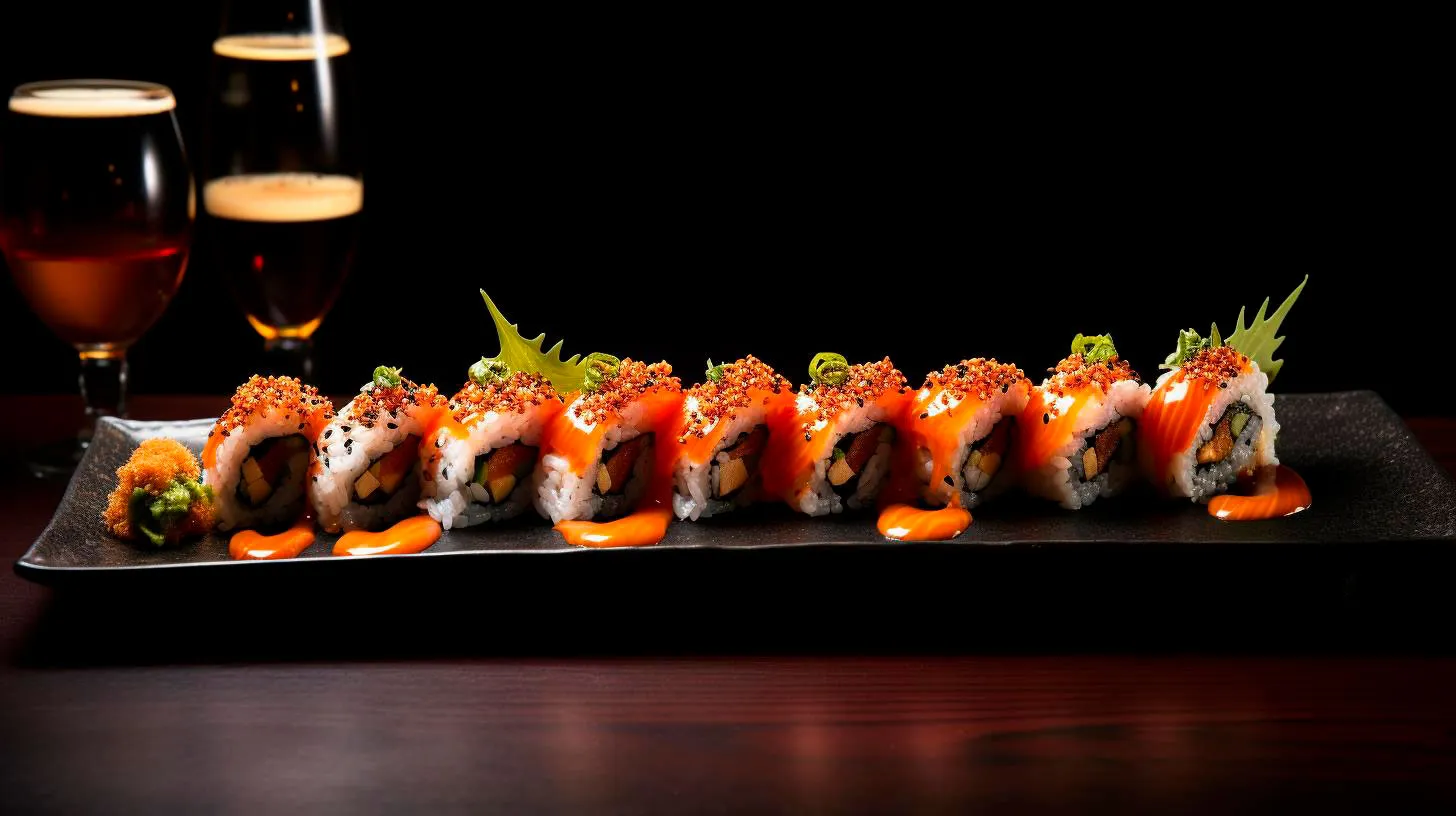Mastering the Perfect Texture and Flavor of Sushi Rice
Often overlooked, the rice plays a crucial role in determining the overall texture and flavor of the sushi. In this article, we will delve into the secrets of preparing the perfect sushi rice, with a focus on achieving the ideal texture and flavor that will elevate your sushi-making skills to new heights.
The Importance of Properly Cooked Rice
Before we dive into the details, let’s understand why properly cooked rice is critical for exceptional sushi. The ideal sushi rice should have a sticky texture that holds the shape when rolled, while still maintaining individual grains that don’t clump together. Achieving this balance may seem intimidating, but with the right knowledge and techniques, you can master the art of sushi rice preparation.
Choosing the Right Type of Rice
When it comes to sushi rice, not all rice varieties are created equal. Traditionally, Japanese short-grain rice, also known as Japonica rice, is used for making sushi. This type of rice has a higher starch content than other varieties, giving it the desired stickiness that is essential for sushi rolls. Look for rice labeled specifically for sushi or any short-grain rice variety that has good stickiness and is available in your area.
Key Takeaway: Choosing the right type of rice, such as Japanese short-grain rice, is crucial for achieving the perfect texture and stickiness in sushi rice.
Rinsing and Soaking the Rice
Properly rinsing and soaking the rice is the foundation of achieving the desired texture and flavor. Start by measuring the appropriate amount of rice, depending on the number of servings you wish to prepare. Next, rinse the rice under cold water until the water turns clear, removing excess starch. This process not only ensures cleaner rice but also helps in achieving the ideal texture.
Once rinsed, let the rice soak in cold water for around 30 minutes before cooking. This step allows the grains to absorb water gradually, resulting in evenly cooked rice with a delightful texture.
Key Takeaway: Rinsing and soaking the rice before cooking helps in removing excess starch and obtaining evenly cooked rice with the desired texture.
Perfecting the Cooking Process
Now that your rice is rinsed and soaked, it’s time to cook it to perfection. The traditional method of cooking sushi rice involves using a rice cooker, but you can also use a pot on the stovetop. Follow these steps for foolproof sushi rice:
- Add the soaked rice and the appropriate amount of water to the rice cooker or pot.
- Cook the rice according to the instructions on the package or rice cooker manual.
- Let the cooked rice rest for around 10 minutes to allow steam to redistribute.
- Prepare the sushi vinegar mixture by combining rice vinegar, sugar, and salt.
- Gently transfer the cooked rice to a wooden or non-metallic bowl using a rice paddle.
- Gradually pour the sushi vinegar mixture over the rice while gently folding it in with a slicing motion. Avoid stirring vigorously to prevent mushing the rice.
- Continue folding and cooling the rice with a fan until it reaches room temperature. This step helps in achieving the ideal stickiness and flavor of sushi rice.
Key Takeaway: Cooking the rice properly and flavoring it with sushi vinegar mixture is crucial to achieve the authentic taste and texture of sushi rice.
Seasoning with Sushi Vinegar
Seasoning the cooked rice with sushi vinegar is what gives it that unique tangy flavor and enhances its overall taste. The sushi vinegar contains a mix of rice vinegar, sugar, and salt, providing the perfect balance of acidity and sweetness. The amount of sushi vinegar you need will depend on your taste preferences, but a general guideline is using around 1/4 cup vinegar for every 3 cups of cooked rice.
Key Takeaway: Properly seasoning the cooked rice with sushi vinegar is essential for obtaining the authentic and delicious flavor of sushi rice.
Ensuring the Right Temperature
Temperature plays a vital role in the texture and overall quality of sushi rice. It is important to cool the seasoned rice to room temperature to preserve its stickiness and allow easy handling for sushi-making. Using a fan or fanning the rice manually while it cools helps to remove excess moisture and achieve the desired texture. Remember, hot or warm rice is more likely to fall apart or become mushy, making it difficult to create perfect sushi rolls.
Key Takeaway: Cooling the seasoned rice to room temperature helps in preserving stickiness and achieving the perfect texture for sushi.
Final Thoughts
Mastering the art of sushi rice is an essential step towards becoming a skilled sushi chef. By selecting the right type of rice, rinsing and soaking it correctly, cooking with precision, and seasoning it perfectly, you can ensure that your sushi rice has the ideal texture and flavor. With practice and attention to detail, you will be able to dazzle your friends and family with restaurant-quality sushi right at home.
Remember, the key to mastering any skill is patience and practice, so don’t get discouraged if your first attempts aren’t perfect. With time, you will refine your techniques and develop your own unique style of sushi-making.
The Art of Balancing Sugar and Salt in Sushi Rice
In this article, we will explore the art of balancing sugar and salt in sushi rice, and how this delicate equilibrium enhances the overall sushi experience.
The Importance of Properly Seasoned Sushi Rice
While many people focus on the freshness and quality of fish or other ingredients when it comes to sushi, the rice itself plays a crucial role. Sushi rice is more than just plain steamed rice; it is a flavor-packed element that complements the toppings and fillings of the rolls. To achieve the perfect taste and texture, it is essential to season the rice with sugar and salt.
Properly seasoned sushi rice not only enhances the overall flavor but also facilitates the formation and stability of the sushi rolls. The balance between sugar and salt is key to achieving this delicate equilibrium.
Understanding the Role of Sugar
Sugar is a crucial component in sushi rice and serves multiple purposes:
- Enhances the sweetness: The addition of sugar gives the rice a subtle sweetness that enhances the flavors of the sushi roll.
- Provides stickiness: Sugar helps bind the rice grains together, giving the sushi its characteristic shape and texture.
- Aids in the fermentation process: Sugar provides nourishment for the beneficial bacteria during the fermentation process, which contributes to the unique taste of sushi rice.
Finding the Right Balance with Salt
Salt is equally important in achieving the perfect sushi rice:
- Enhances the savory flavor: Salt brings out the savory notes in the rice and complements the various fillings and toppings used in sushi rolls.
- Acts as a preservative: Salt helps prevent the growth of harmful bacteria, ensuring the rice remains fresh and safe to consume.
- Provides balance: Salt balances out the sweetness from the sugar, creating a harmonious flavor profile in the sushi rice.
Tips for Balancing Sugar and Salt in Sushi Rice
Creating well-seasoned sushi rice requires careful consideration and practice. Here are a few tips to help you achieve the perfect balance of sugar and salt:
- Use high-quality rice: Start with the best quality sushi rice, as the flavor and texture of the final dish heavily depend on the rice itself.
- Follow the recipe: Always refer to a reliable recipe that provides the correct ratios of sugar, salt, and rice vinegar for seasoning.
- Adjust according to taste: Taste the rice as you season it, and make adjustments to the sugar and salt quantities based on your personal preferences.
- Allow time for absorption: After seasoning the rice, let it sit for a few minutes to allow the flavors to meld and the rice to absorb the sugar and salt.
The Key Takeaways
Mastering the art of balancing sugar and salt in sushi rice is crucial for creating exceptional sushi rolls. Remember these key takeaways:
- Properly seasoned sushi rice enhances the overall flavor and stability of sushi rolls.
- Sugar adds sweetness, stickiness, and aids in fermentation.
- Salt enhances the savory flavor, acts as a preservative, and provides balance.
- Follow reliable recipes and adjust seasoning based on personal taste.
- Take time for the flavors to meld and the rice to absorb the seasoning.
By mastering the art of balancing sugar and salt in sushi rice, you can elevate your sushi-making skills and create delectable rolls that will impress your friends and family. So, grab your sushi mat, favorite fillings, and start perfecting your sushi rice for a truly unforgettable dining experience.
Understanding the Role of Rice Vinegar in Sushi Rice
In this article, we will explore the significance of rice vinegar in sushi rice and uncover its unique contributions to the overall sushi experience.
The Importance of Rice Vinegar
Sushi rice, also known as shari or sumeshi, is the foundation of any sushi roll. It provides the perfect balance of stickiness, moisture, and flavor that complements the other ingredients. Rice vinegar serves as the key seasoning agent for sushi rice, enhancing its taste and helping to achieve the desired texture.
- Flavor enhancement: Rice vinegar adds a subtle tanginess and mild sweetness to sushi rice. Its delicate flavor elevates the taste of the rice and brings harmony to the various ingredients in a sushi roll.
- Texture and consistency: Rice vinegar plays a crucial role in determining the texture and consistency of sushi rice. Its acidic properties help to break down the starches in the rice, resulting in a stickier and more compact rice grain.
- Preservation: Traditionally, sushi rice was seasoned with vinegar not only for flavor but also for preservation purposes. The acetic acid in rice vinegar helps to inhibit the growth of bacteria, ensuring the sushi rice remains fresh and safe to consume.
Choosing the Right Rice Vinegar
When it comes to selecting the ideal rice vinegar for sushi rice, not all vinegars are created equal. The two main types of rice vinegar used in sushi are seasoned rice vinegar and unseasoned rice vinegar. Here is a breakdown of each:
Seasoned Rice Vinegar:
Seasoned rice vinegar is a popular choice for sushi rice as it already contains additional ingredients such as sugar and salt. This ready-to-use vinegar simplifies the seasoning process and ensures a consistent flavor every time. However, it is important to note that different brands may have varying levels of sweetness and saltiness, so it is recommended to taste and adjust accordingly.
Unseasoned Rice Vinegar:
Unseasoned rice vinegar, on the other hand, is pure rice vinegar without any added ingredients. This type of vinegar offers more control over the flavor profile, allowing sushi chefs to adjust the sweetness and saltiness to their preference. It is a versatile option and can also be used in other Japanese dishes.
Key Takeaways
- Sushi rice is the foundation of any sushi roll, and rice vinegar is an essential ingredient for its flavor and texture.
- Rice vinegar enhances the taste of sushi rice with its tanginess and mild sweetness.
- Acetic acid in rice vinegar helps preserve sushi rice by inhibiting bacterial growth.
- Choosing the right rice vinegar, whether seasoned or unseasoned, is crucial for achieving the desired flavor profile.
Next time you enjoy a delicious sushi roll, take a moment to appreciate the subtle yet significant role that rice vinegar plays in enhancing your dining experience. The perfect balance of flavor and texture in sushi rice owes its thanks to this humble ingredient!



